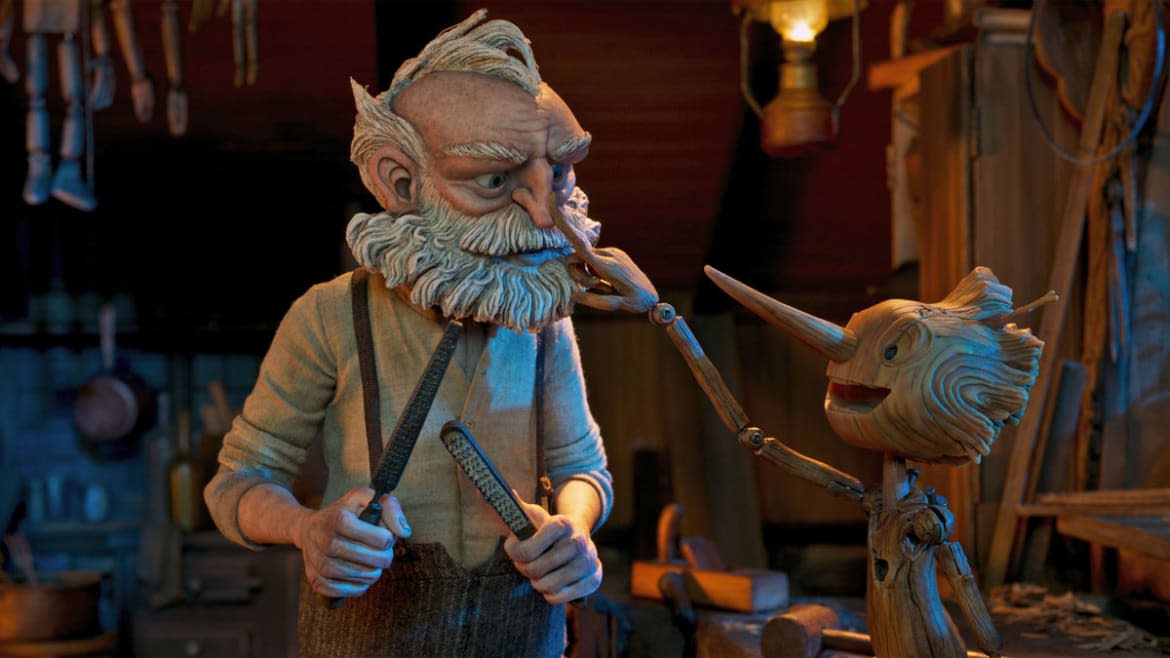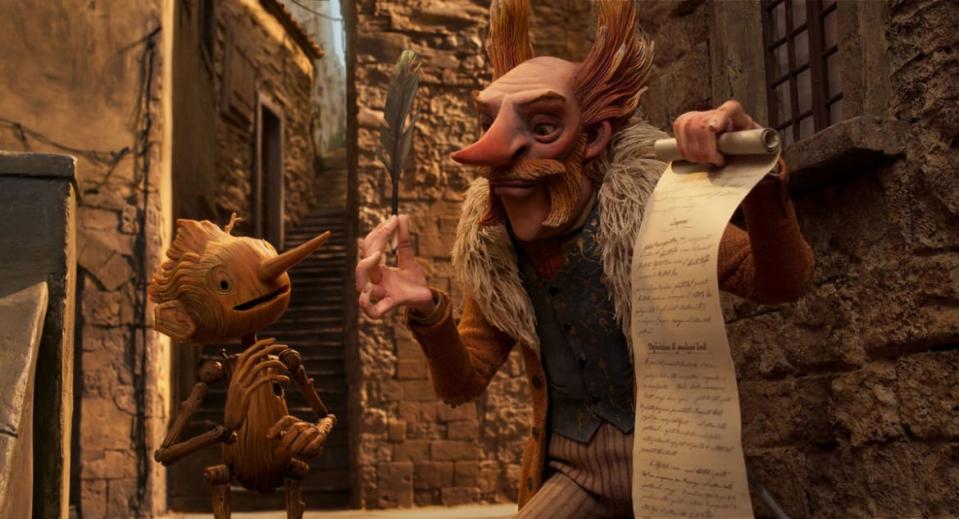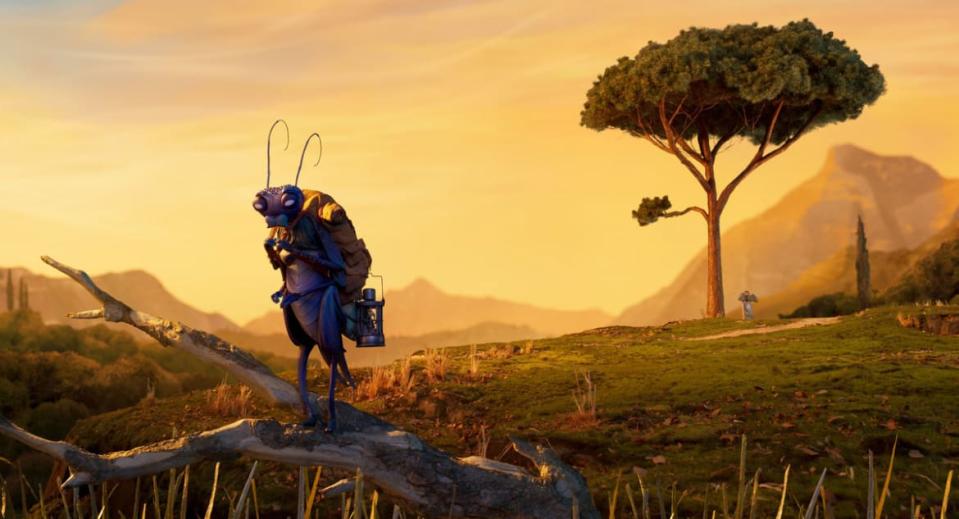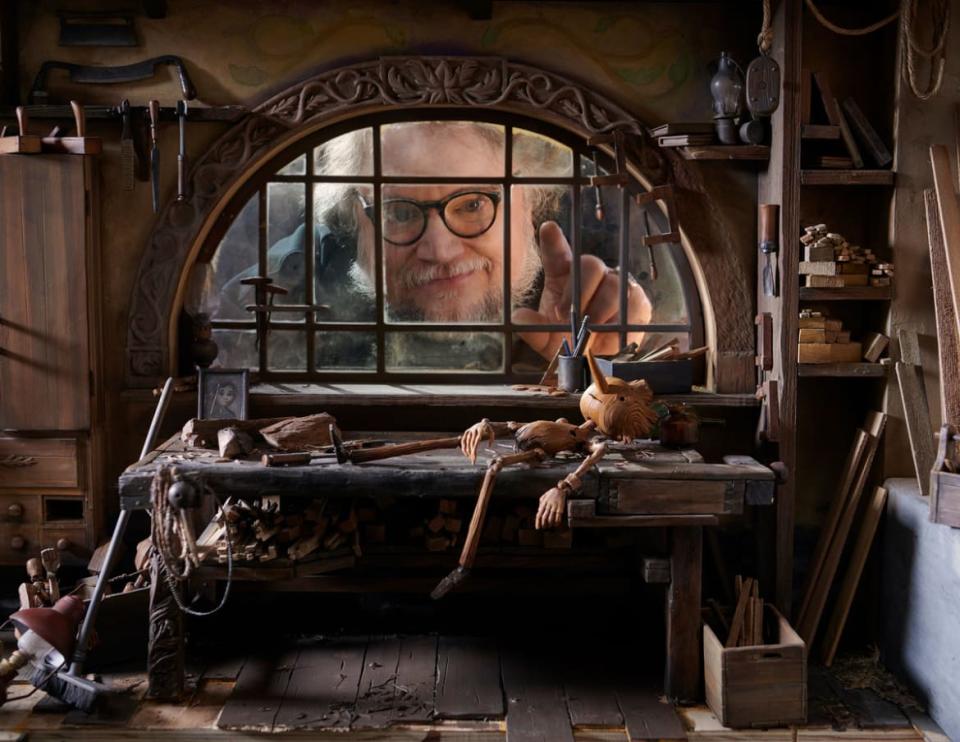Guillermo Del Toro Has Done the Impossible: Make a Good ‘Pinocchio’ Remake

- Oops!Something went wrong.Please try again later.
- Oops!Something went wrong.Please try again later.
Stop me if you’ve heard this one before: There’s a new Pinocchio movie. No, not Robert Zemeckis’ apocalyptically bad live-action adaptation of the 1940 Disney film. And no, not Pinocchio: A True Story, a film nobody in recorded history has seen, but whose star Pauly Shore’s legendarily camp line reading of “Father, when can I leave to be on my own?” brought great joy to the internet at the beginning of the year. I’m talking about Guillermo del Toro and co-director Mark Gustafson’s stop-motion film, a passion project that’s taken over a decade to get made.
After spending an eternity in development hell before getting picked up by Netflix, del Toro’s vision of Pinocchio finally premiered at this year’s London Film Festival. With so many different adaptations in existence (this is the third this year alone), I was nervous heading into del Toro’s film. Does the world really need another freaking movie about a wooden puppet come to life? What can this film possibly offer that we haven’t seen countless times before?

Thankfully, del Toro’s passion project answers both of those questions with a resounding “yes.” This Pinocchio (2022) is leagues ahead of its long-nosed competitors, though that’s an admittedly low bar. The film manages to find something new and exciting, taking a considerable number of liberties from Carlo Collodi’s original novel The Adventures of Pinocchio, while capturing a lot of what makes the story so timeless.
By now, you’re likely quite familiar with the general story of Pinocchio—Geppetto (David Bradley), a hugely talented craftsman, who creates a life-size wooden puppet named Pinocchio (Gregory Mann). Thanks to some good old-fashioned magic, the puppet comes to life, and endless chaos and hijinks ensue. In this adaptation, there’s a much greater focus on fatherhood, especially through Geppetto’s relationship with his son Carlo (an homage to Collodi, no doubt) and, later, Pinocchio.
When Geppetto tragically loses Carlo, he falls into a deep depression, giving up on his career to stay by his son's tomb. He creates Pinocchio, hoping to bring back his dead son through the puppet. Overnight, the Wood Sprite (Tilda Swinton) grants Gepetto’s wish, turning Pinocchio into a real boy. There’s something quite grotesque about it all, and del Toro leans into it, turning the enchanting creation of Pinocchio into a drunken, grief-stricken scene.
This is all witnessed by Sebastian J. Cricket (Ewan McGregor), who was living in the tree Geppetto cut down to make his puppet. Sebastian is our narrator and resident scene-stealer; most of the film’s best jokes center around this beloved cricket. Sebastian is also tasked by the Wood Sprite to help Pinocchio learn to be a good, upstanding young boy—which surely can’t be too difficult…right?

Wrong. Pinocchio himself is most politely described as a rambunctious little asshole. He couldn’t care less about instructions and is keen on doing whatever he wants, regardless of what any authority figures tell him unless there’s chocolate involved. This kid is absolutely awful, and a terrific vocal performance from Gregory Mann wonderfully channels Pinocchio’s indignation. This is very faithful to the original story although it's toned down a bit here; in the book, Pinocchio doesn’t just squash the cricket. He murders him.
Pinocchio’s other considerable deviation is that the film is set in 1930s Italy, under fascist rule by one Benito Mussolini. The fascist setting isn’t merely window-dressing. It casts a shadow over the entire film and becomes a big part of the story. Wide-eyed Pinocchio is eventually recruited by Count Volpe (a delightfully camp Christoph Waltz) and his monkey assistant Spazzatura (Cate Blanchett) to join his traveling circus as its star, with promises of endless candy and hot chocolate. Volpe, our primary antagonist (though this is Pinocchio, so there are many) is a dedicated member of the regime, and all of Pinocchio’s performances are about glorious Italy. Pinocchio’s stardom ultimately climaxes in an epic performance for “Il Duce,” Mussolini himself; it’s a hilarious moment, thanks to Pinocchio’s dislike of authority figures and dazzling irreverence.
Critiques of fascism manifest throughout, particularly in the way it explores how people blindly follow an ideology, and the way such ideas can spread like wildfire. It explores the way it these ideas can start with a few off-hand comments and spiral into a full-blooded movement. There are crowds of people cheering wildly for Il Duce, and there’s even an extended sequence at a youth military camp — Pinocchio’s abilities as a puppet catch the eye of the military, who want to turn him into the ultimate soldier. While the social criticism is bold and obvious, the choice to steep the film in a fascist setting feels timely and timeless, while allowing the film to really lean into its darkness.

Guillermo del Toro is a beloved filmmaker because his passion for cinema and his love of his creations is always evident when watching his films. That’s especially true of Pinocchio, where you can not only feel the love but see it in its meticulously detailed and incredibly beautiful rendition of 1930s Italy. The environments are incredible, and the effects are honestly mind-blowing—during a crucial story moment, I couldn’t stop myself from looking at the water washing up on the sand. I have no idea how they managed to make it look so incredibly real, and honestly, I never want to find out.
The character designs are sensational, and the craftsmanship is next level. This is a film that apparently took a stunning 1,000 days of production, and in terms of sheer visual excellence, that time was not in vain. The visuals are often highly stylized, yet they still maintain a sense of breathtaking life to them. I audibly gasped when the magnificent Wood Sprite appeared and was equally astonished when Death (also Swinton) arrived. Then there’s the creature that swallows them all whole, some sort of mortifying whale-catfish hybrid that is as terrifying as it is beautiful. There really aren’t any misfires here: This has been a brilliant year for stop-motion animation, and Pinocchio is the cream of an especially delicious crop.
While Pinocchio is largely a wonderful experience, it’s let down by its need to be a musical. There are quite a few songs front-loaded into the first act of the film, which ends up weighing things down. They’re generally forgettable and don’t make for much of an impact—nothing here comes close to the power of the surprising musical interlude in del Toro’s 2017 film, The Shape of Water. They’re effective when grounded in Pinocchio’s role as a performer— the song “Everything is New to Me” is a charming, funny way to set up Pinocchio as a character, for instance. But most of the soundtrack feels superfluous, coming across as exposition rather than exciting numbers.
At 75, Pinocchio Is Still The Finest Hand-Drawn Film Ever
Thankfully, Pinocchio seems to forget it’s a musical as it goes on, and it’s all the better for it. Leave most of the songs on the cutting room floor, and you’ve got a punchier, better-paced story. And while the songs rarely land, Alexandre Desplat’s instrumental score is wondrous, expertly channeling a magical whimsy drenched in melancholy.
As both a stop-motion marvel and an exciting, dark story, Pinocchio is a rousing success. It’s in tune with the original book, yet it still forges an entirely different path of its own. That’s a key moral in Pinocchio, by the way: Follow your own unique journey in life, and don’t let anyone get in the way of going after what you want. Its messages are clear, but not ham-fisted, and while this is a film for the whole family, it never talks down to children. This is a mature, sophisticated take that does exciting, unexpected things with a well-worn tale. It’s not Disney’s animated masterpiece, but it’s not trying to be—this is a movie too busy traveling its own thrilling adventure.
Get the Daily Beast's biggest scoops and scandals delivered right to your inbox. Sign up now.
Stay informed and gain unlimited access to the Daily Beast's unmatched reporting. Subscribe now.

